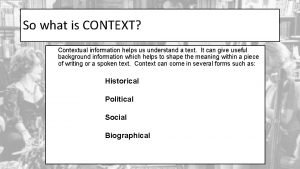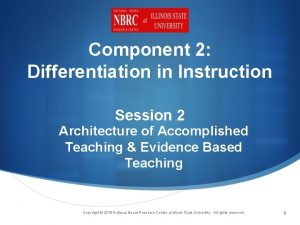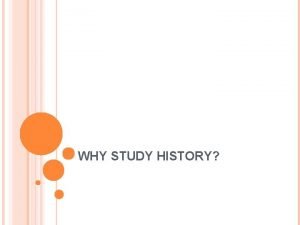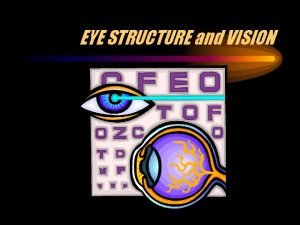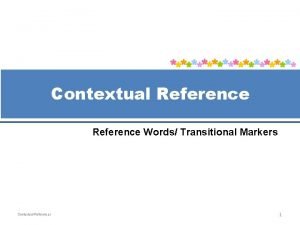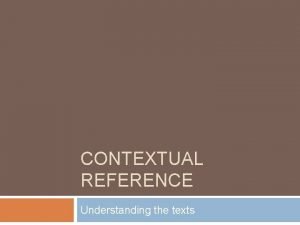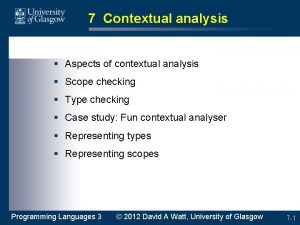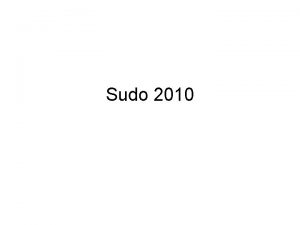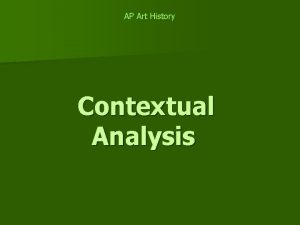So what is CONTEXT Contextual information helps us













- Slides: 13

So what is CONTEXT? Contextual information helps us understand a text. It can give useful background information which helps to shape the meaning within a piece of writing or a spoken text. Context can come in several forms such as: Historical Political Social Biographical

When revising for AO 3 for ‘Who’s Afraid of Virginia Woolf’ we need to consider the following questions. . • What do we know about the playwright? • When was the play set? • Where is the play set? • What can you say about the play as a Post Modern play? • How does it reflect Gender roles? • What about the American Dream? 2

Revise the playwright. . . You have to find out about Edward Albee and the time he lived in. • What can you say about his other works? • Has the playwright’s own life experiences affected their handling of theme / presentation of the characters in the play? • Does the gender of the playwright impact meaning? • Does the social class?

Research Edward Albee

Think about the when and where. . . • When was the play written? • When was it set? • What were the major political/historical events of these periods? e. g. wars, depression, industrialisation etc. . . • How are these events evidenced in the text? 5

Research the where and when • You need to find out when was the play written. • When was it set? • What were the major political/historical events of these periods? e. g. Cold war? The American Dream • How are these events evidenced in the text? “The American Dream” is one of the most evocative phrases in American culture. Americans know instinctively what it means—a fair chance to succeed in open competition with fellow citizens for the good things in life—wealth, power, security, happiness, material goods. The grand promise of the American Dream has always been that those willing to learn, work, save, persevere, and play by the rules would have a better chance to grow and prosper in America than virtually anywhere else on earth. That one can be born into poverty and pull himself or herself out of that poverty through hard work and intelligence and be successful.

“We hold these truths to be self-evident, that all men are created equal, that they are endowed by their Creator with certain unalienable Rights, that among these are Life, Liberty, and the PURSUIT of Happiness” Declaration of Independence written in 1776 by Thomas Jefferson Is it true that people are free to pursue success and financial security in the play? Do some have an easier time pursuing success than others? Do people have an equal chance in life to pursue their dreams and goals?

Find out about The Cold War and how it is illustrated in the play. • The Cold War is the name given to the relationship that developed primarily between the USA and the USSR after World War Two. The Cold War was to dominate international affairs for decades and many major crises occurred – the Cuban Missile Crisis, Vietnam, Hungary and the Berlin Wall being just some. For many, the growth in weapons of mass destruction was the most worrying issue.

THE AUTHOR AND HIS TIMES In 1962 the United States was enjoying what many now consider a period of innocence. John F. Kennedy, the youngest man ever elected President, was in office, revitalizing a country some observers considered passive and complacent when he was inaugurated in 1961. Relative peace reigned in most of the world, and in the United States traditional values appeared unshakable. Hardly anyone would have predicted the great turmoil the country was about to undergo- the Vietnam War; the assassinations of President Kennedy, Senator Robert F. Kennedy, and Reverend Martin Luther King, Jr. ; and the scandal of Watergate that led to the resignation of President Richard M. Nixon in 1974. Yet, if the surface was tranquil in 1962, there was nonetheless considerable agitation underneath. American relations with the Soviet Union were often extremely tense in the early 1960 s, resulting in confrontations over Berlin and Cuba. In the United States, attempts by blacks to end racial discrimination not infrequently were countered by violence by whites. And a number of influential writers were questioning the American values that seemed so secure. On October 13, 1962, a play opened on Broadway in New York City that was one of the first popular successes to articulate these undercurrents of dissatisfaction, of unease about America. That play, Edward Albee’s Who’s Afraid of Virginia Woolf? , critically analyzed institutions and values that Americans held dear - family, marriage, and success, for instance- and suggested they might have been created in part to escape from reality. Albee’s play set loose a cyclone of controversy. It was the rare case of a play created for the commercial theatre presenting a full-scale investigation of sacred American traditions, and it did so in shocking language that many found disturbing. Yet for every person who found Who’s Afraid of Virginia Woolf? “perverse” and “dirty-minded, ” there were those who labelled the play a masterpiece and declared Albee to be “one of the most important dramatists of the contemporary world theatre. ” Debate raged over the play, and opinions were even offered by people who had never seen or read it!

Who is the man who nearly turned theatre world upside down in 1962? It’s not an easy question to answer, since Edward Albee always has been an intensely private man. Anyone who looks to Albee’s life for hints about his work probably will be disappointed, for few modern writers have been so guarded about their past and protective of their privacy. In a 1981 interview Albee was asked how important his biography was as a key to understanding his work. He responded: “I think totally unimportant. I’d rather people judge the work for itself rather than by biographical attachments. ” You may not agree with Albee about how much your knowledge of an author’s life helps you understand his work, but Albee’s philosophy of allowing the work to speak for itself deserves respect. The facts known about Albee’s early life come from the information he has made public, plus the reminiscences of long time friends. Albee was born in Washington, D. C. , on March 12, 1928, to parents whose identities are unknown. He was placed in an orphanage at birth, and at the age of two weeks he was adopted by Reed and Frances Albee, who took him to live in New York City. He was named Edward Franklin Albee after a grandfather, who was part owner of the Keith-Albee Circuit, an extremely successful string of vaudeville theatres. The Albee family was wealthy, and young Edward’s life was one of luxury. His childhood included private tutors, servants, luxury automobiles, winters in warm climates, excursions to theatre, and riding lessons. But such privilege as a child did not result in a pampered complacency when he grew up. In fact, as you shall see, Albee used his pen to criticize the moral and spiritual damage inflicted upon people by an excess of material wealth and a misguided pursuit of the “American dream. ”

Albee’s explosion on theatrical scene came at a time when the American commercial theatre had been dominated by playwrights such as Arthur Miller, Tennessee Williams, and William Inge. These writers worked for the most part in a realistic idiom, in which the world onstage essentially mirrored the world of the audience. The world was observed objectively, and in ways that generally echoed traditional values and supported the beliefs of the audience. These plays told the members of the audience that men and women were basically responsible for determining their own fate. Some playwrights of the time, particularly Europeans like Samuel Beckett, Jean Genet, and Eugene Ionesco, were responding differently to the world. World War II and the potential horrors of the nuclear age compelled these writers to see the universe as a place where humans had lost control. They were eager to shake audiences out of a sense of complacency about their lives. They wanted the spectator to feel their deep-seated anguish at the absurdity of the human condition. Nothing happens, nothing changes, these writers say. The world is out of control and nothing we can do will change this disturbing condition. This attitude of hopelessness prompted the critics to loosely categorize these writers as Absurdists. Plays of the Theatre of the Absurd, such as Beckett’s Waiting for Godot (1953) and Endgame (1957) and Ionesco’s The Bald Soprano (1950), share certain characteristics. Speech is often deliberately confusing and not logical. The patter is filled with jargon, clichés, even nonsense, as if to tell us that language itself is empty and our attempts to communicate deep feelings are futile. Dramatic and realistic characters are frequently eliminated. The plays are often merely a series or incidents or images that represent the turmoil of the human condition as the author sees it. Also, absurdist plays are often very funny- sometimes insanely so- suggesting that laughter is the only response to the pain of life in a world devoid of hope or purpose. Albee’s work includes both realistic and absurdist techniques. He is often seen as a link between these two movements. On one level, The Zoo Story tells of an “ordinary” meeting between two men in a park. Peter is a comfortable middleclass businessman, the upholder of traditional American values, complete with wife, children, and pets. Jerry is an outcast and a rebel, a man who has chosen to remove himself from the mainstream by living a solitary, introspective existence. The play concerns Jerry’s desire to communicate with Peter on something more than a superficial level, and when his initial attempts fail, he compels Peter to murder him, suggesting that only violence or death can bring communication at a deeper level. The themes of communication through violence and the hollowness of American values that Albee explores in The Zoo Story link him with the absurdists, as does Jerry’s death, which has been likened to the death of the student in Ionesco’s play The Lesson. (These two themes and a death surface again in Who’s Afraid of Virginia Woolf? )

Who’s Afraid of Virginia Woolf? explores themes- death, sterility, the corruption of the American dream- similar to Albee’s earlier one-act plays. In some ways this full-length play is more realistic than its predecessors. It has a recognizable setting and more commonplace characters. But the absurdist influence is there too- in the imaginary child that George and Martha have created in the characters’ inability to communicate except through abrasiveness and violence, and in the frequent use of clichéd speech. It is the successful blending of realism and absurdism that has prompted audiences to applaud Albee’s innovations. Yet some readers feel that the play would be better served by a non-realistic production, perhaps a blank stage rather than the detailed setting it’s usually given. The controversy generated by the play’s Broadway opening reached a climax with the awarding of the Pulitzer Prize for Drama, one of the most prestigious of all drama awards. The committee chosen to select the winning play voted to give the prize to Who’s Afraid of Virginia Woolf? , but the trustees of Columbia University, the overseers of the award, decided to deny the play a Pulitzer. They perhaps felt that its explicit language and its exploration of “taboo” subjects made it too controversial a choice.

Remember. . • Context MUST be EMBEDDED into the essay • You SHOULD NOT simply include a section of context at the start of the essay which is unconnected to the main argument • Best practice links contextual information to language analysis.
 What is context information
What is context information Domain 4 examples
Domain 4 examples High context vs low context culture ppt
High context vs low context culture ppt Communicating across generational differences
Communicating across generational differences Deictic expressions
Deictic expressions Paraverbal adalah
Paraverbal adalah History helps us understand people and societies
History helps us understand people and societies Strategic organization speech
Strategic organization speech Fatty casing that helps speed neurotransmission
Fatty casing that helps speed neurotransmission Leader development marines
Leader development marines Hibernation is an adaptation that helps animals to _______.
Hibernation is an adaptation that helps animals to _______. Church helping community
Church helping community How does diffusion help maintain homeostasis
How does diffusion help maintain homeostasis What helps maintain the eyeball's spherical shape
What helps maintain the eyeball's spherical shape
